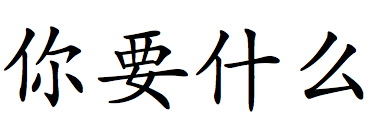Ni yao shen me is the pinyin for 4 characters:
* ni 你
* yao 要
* shen 什
* me 么
and it means “What do you want?”
ni = you
yao = want
shenme = what
Expanding The Pattern
By changing the first word ni/你 (meaning “you”) to ta (the 3rd person personal pronoun meaning he, she, and/or it), your new sentence (question) is
Ta yao shenme (what does he/she/it want?)
There’s no need to change the verb, worry about agreement, etc. Just change the pronoun. Note that ta means he/she/it and is spoken identically for all 3, though it is written differently 他,她,它 (he, she, it).
Ni yao shenme (What do you want)
becomes
Ta yao shenme (What does he/she/it want)
Plural personal pronouns are formed by adding men/们 to the 3 singular personal pronouns. Wo, ni, and ta (I, you, he/she/it) become women, nimen, tamen. Note that there is no subjective-objective difference in Mandarin, so I and me are both wo/我, and so on.
Wo = I, me
Ni = you, you
Ta = he/she/it, him/her/it
Women = we, us
Nimen = you, you
Tamen = they, them
Get more info on personal pronouns in English and in Chinese.
Note on zanmen:
The usage of zanmen is common in Mandarin as meaning “we” or “us”, it is a variation of women. It emphasizes that the speaker is part of the group considered “we or us”. Used colloquially, written as 咱们.

1 Comment
1 Pingback